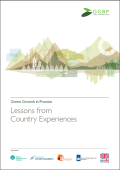
Green growth is becoming an attractive opportunity for countries around the world to achieve poverty reduction, environmental protection, resource efficiency and economic growth in an integrated way. Green growth strategies generate policies and programs that deliver these goals simultaneously. They accelerate investment in resource efficient technologies and new industries, while managing costs and risks to domestic taxpayers, businesses, communities and consumers.
This report carried out by the Green Growth Best Practice (GGBP) initiative, is the first comprehensive international assessment of lessons from experiences of pursuing green growth across all levels of government and all regions. The report is the result of a collaborative partnership between the Climate & Development Knowledge Network (CDKN), the European Climate Foundation (ECF) and the Global Green Growth Institute (GGGI). It engaged 75 authors in evaluating more than 60 programs around the world.

As an increasing number of countries adopt green economy strategies, there is a need to support them in measuring the magnitude of this new economy. This papers aims to guide them in this discussion. An Environmental Goods and Services Sector (EGSS) framework is a vital instrument for facilitating the greening of the economy, as it encompasses the two priority areas for green economy indicator development, namely the greening of conventional economic activities and the growing share of green or environment-related sectors.

This paper offers an initial assessment of the use, potential usefulness and legality of local content requirements (LCRs) in renewable energy policy. By scrutinising existing empirical evidence on LCRs, the authors identify a number of initial basic conditions that determine the effectiveness of such measures in creating domestic industries. The paper provides an in depth analysis of the wind LCR in China, and descriptive analyses of other LCRs used in the promotion of renewable energy around the world. It further qualitatively addresses the question whether or not local content requirements and medium-term innovation could be aligned. Finally, it discusses the legality of the measures under WTO law.
Other case studies include Canada, Spain, Italy, France, Greece, Croatia, the United States, India, Brazil, South Africa and Turkey.
In October 2013, Ontario Premier Kathleen Wynne announced her government’s plan to issue green bonds. The Government of Ontario will be the first province in Canada to issue green bonds, but not the first government agency in Canada to do so. Export Development Canada issued a green bond in January 2014, and TransLink, Metro Vancouver’s regional transportation authority, has issued very similar bonds without adding the ‘green’ label. The Ontario government plans to use the bond proceeds for investment in "transit and other environmentally friendly infrastructure projects across the province." At press time, the Government of Ontario had not released further details regarding the specific allocation of the bonds’ proceeds.
The Road to Rio+20 publications, by the United Nations Conference on Trade and Development provide a series of essay compilations, all based around the ‘what’, ‘why’ and ‘how’ of making the transition to a development‐led green economy. Road to Rio+20 comprises three issues released in March 2011, November 2011 and June 2012.
The first issue aims to contextualise the green economy, examine the pros and cons from different perspectives, identify the critical issues and provide a case study to look at a specific green economy initiative. The second issue provides a series of real world references for governments, businesses and civil society; what is referred to in this volume as ‘pathways to a development‐led green economy’. The third issue moves forward the debate, focusing primarily on commitments and outcomes and the potential of Rio+20 to generate innovative ideas, policies and to consolidate sustainable development strategies of governments.
